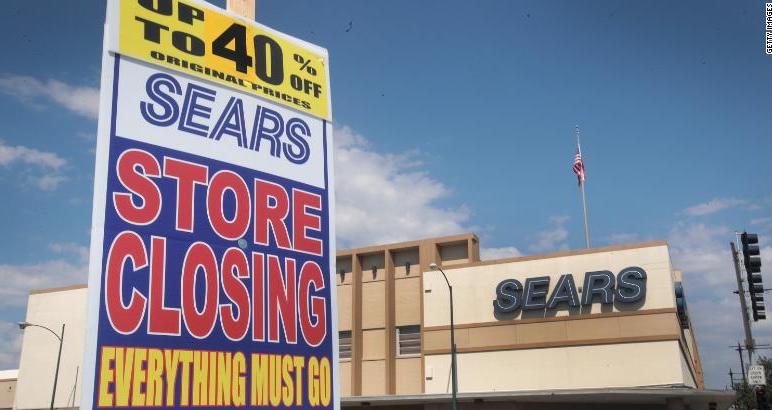Last week, the Wall Street Journal reported that Sears, the high-profile American department store chain founded in 1892 with 506 stores, was prepared to file for bankruptcy due to continuing financial pressure.
As reported on Inside Retail, Neil Saunders, of Global Data Retail, said the news was ‘no great surprise’.
“Put bluntly, it has failed on every facet of retailing; from assortment, to service, to merchandise, to basic shopkeeping standards.”
The harsh reality of this situation, a loss of jobs and vacant retail spaces, is daunting. Sears are currently looking into possible alternatives, but the general narrative around the business portrays their prospects look bleak with the department store’s performance at an all-time low.

Image: Getty Images
How did Sears get to this point?
Saunders describes how fundamental best practices were missed by Sears and that they failed to keep up with the rapidly changing expectations of their customers. Unfortunately for the retail sector, this is not an isolated case, when we track global department store performance, many of them are showing signs of struggle.
Other department stores’ performance statistics:
John Lewis – who had weathered the global financial crises so well, reported an 99% fall in first half profits, in the 26 weeks to the 28th July 2018
Debenhams – reported an 85% fall in first half profits, in the 26 weeks to the 3rd March 2018
Myer – reported net profit halved to $32.5m in the 52 weeks to July 2018, resulting in a statutory net loss of $486 million due to $518.5 million of exceptional costs.
David Jones – reported a 58.3% drop in operating profit due to expenses incurred through online reform, store openings and evolution of its food format.
So, why are we seeing so many department stores struggle?
Department stores emerged in the mid-19th century, redefining the customer shopping experience with service and luxury. Their dominant position came under threat with the influx of discount retailing, followed by the online explosion. While discount retailers represented a challenge of perceived customer value and price comparisons, online shopping brought a whole new problem, challenging a department stores’ unique selling proposition.
What was the department store USP? Offering the ‘family solution’ – catering for everyone’s needs with a portfolio of brands across a multitude of departments offering well-established quality. Online shopping brought an end to this USP, providing a new, one-stop-shop solution, with the convenience of home-buying. Giants such as Amazon offer millions of products with delivery options and shopping experiences that continue to delight their customers.
What do we learn from this?
It is clear from recent financial reports that there is a fine balance between investing in innovation, improvement and transformation and managing the fundamental profit of the business, that is yet to be defined for many retailers. We can see from the above data that without prioritising investment in these key aspects, the profit and sustainability of the business will suffer. These former High Street darlings, are facing a chicken and egg situation, as well as continuing criticism of their financial results and operating models. Their customers are speaking with their wallets and investors with deteriorating share prices.
So, what can department stores do to, not only survive, but thrive in this evolving market?
-
- Offer excellent customer service. To remain competitive against the online giants, customer service must be top of mind at every touch point, offering superior service and added value, utilising the face-to-face experience. The concession model, where staff belong to a particular brand needs reform, the customer doesn’t care which brand the assistant works for, they just want great service. And great service delivers increased sales and profits.
- Clearly define the target customer. Be fanatical with understanding the customer, their needs and expectations, and ensure everyone in the organisation understands who they are serving. Too often, customer profiles never make it out of the marketing department.
- Inspire your customer and provide solutions. Once you know your customer, inspire them and provide information and expertise. Retailers think they are all about product, but they should be focussing on providing the solutions to customers’ needs.
- Be an expert in the basics of retailing. With the continued need to evolve and innovate, fundamental best practices are falling down in the order of priorities. Ensure the basics are there with planning, assortment, allocation, pricing hierarchy and promotional strategy.
- Invest in culture. Staff are the biggest cost but also the biggest asset of any retailer. Most retailers will agree that the job is harder than it was 30 years ago. Leading staff through the challenges, offering clear business objectives and creating a resilient culture is vital in leveraging this asset. This means investing in your people and ensuring they have the best learning and development support
- Financially sound, strategic innovation. Critically evaluate costs as a whole and throughout the year. Ensure that innovation costs have been vigorously examined with overall understanding of the financial outcomes.
What have we learned?
The High Street needs department stores. They are the anchor of the shopping strip or mall, providing a place where shoppers can experience a tactile shopping environment and personal service from real people. There is absolutely still a place for retailers who offer a great customer experience, who inform and inspire their customers and deliver excellent face-to-face service.
How do you ensure your department store thrives despite the online-shopping culture?
Invest in training, prioritise smart merchandise planning, invest in your people and create an interactive, personal shopping experience to encourage customer loyalty. If your customers have a great experience and their needs are met – they will come back!
References:
- Inside Retail Sears – https://www.insideretail.com.au/news/world/sears-prepares-to-file-for-bankruptcy-201810
- John Lewis Guardian – https://www.theguardian.com/business/2018/sep/13/john-lewis-profits-dive-99-percent
- Debenhams- https://www.theguardian.com/business/2018/apr/19/debenhams-profits-slump-52-beast-from-the-east-sales
- Myer- https://www.insideretail.com.au/myer/myer-hit-with-486-million-net-loss-201809
